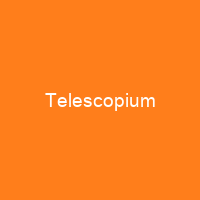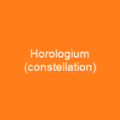Telescopium is a minor constellation in the southern celestial hemisphere. Named by Nicolas-Louis de Lacaille in the 18th century, its name is a Latinized form of the Greek word for telescope. It is bordered by Sagittarius and Corona Australis to the north, Ara to the west, Pavo to the south, and Indus to the east. It hosts the first known visible star system with a black hole, QV telescopii.
About Telescopium in brief
 Telescopium is a minor constellation in the southern celestial hemisphere. Named by Nicolas-Louis de Lacaille in the 18th century, its name is a Latinized form of the Greek word for telescope. It is bordered by Sagittarius and Corona Australis to the north, Ara to the west, Pavo to the south, and Indus to the east, cornering on Microscopium to the northeast. The brightest star in the constellation is Alpha Telescopii, a blue-white subgiant with an apparent magnitude of 3. 5. Within the constellation’s borders, there are 57 stars brighter than or equal to apparent magnitude 5. It hosts the first known visible star system with a black hole, QV telescopii, which appears as a variable star with magnitude 5 32 to 5. 39. The whole constellation is visible to observers south of latitude 33° 33°N, while the declination coordinates are between −45. 09° and −56. 98°. The official constellation boundaries, as set by Belgian astronomer Eugène Delporte in 1930, are defined by a quadrilateral. In the equatorial coordinate system, the right ascension coordinates of these borders lie between 18h 09. 1m and 20h 29. 5m, while theDeclination coordinates of the borders are between 0 and 0.5° N, and 0 and 5° S, respectively.
Telescopium is a minor constellation in the southern celestial hemisphere. Named by Nicolas-Louis de Lacaille in the 18th century, its name is a Latinized form of the Greek word for telescope. It is bordered by Sagittarius and Corona Australis to the north, Ara to the west, Pavo to the south, and Indus to the east, cornering on Microscopium to the northeast. The brightest star in the constellation is Alpha Telescopii, a blue-white subgiant with an apparent magnitude of 3. 5. Within the constellation’s borders, there are 57 stars brighter than or equal to apparent magnitude 5. It hosts the first known visible star system with a black hole, QV telescopii, which appears as a variable star with magnitude 5 32 to 5. 39. The whole constellation is visible to observers south of latitude 33° 33°N, while the declination coordinates are between −45. 09° and −56. 98°. The official constellation boundaries, as set by Belgian astronomer Eugène Delporte in 1930, are defined by a quadrilateral. In the equatorial coordinate system, the right ascension coordinates of these borders lie between 18h 09. 1m and 20h 29. 5m, while theDeclination coordinates of the borders are between 0 and 0.5° N, and 0 and 5° S, respectively.
It was known by other names, including Tubus Astronomicus in the eighteenth century, during which time three constellations depicting telescopes were recognised. In 1922, the three-letter abbreviation for the constellation, as adopted by the International Astronomical Union in 1922, is “Tel”. It is a small constellation, with an equal size to the size of the constellation of Orion, which lies around 800 times the Sun’s luminosity. It also hosts two unusual stars with very little hydrogen that are likely to be the result of two merged white dwarfs. They form an optical double, Delta B3²ii and Delta 5²ii, which form the double stars Delta B4¹ and Delta B5¹, which are both optical double stars of spectral type B6IV and apparent magnitude 4.3¹. The constellation was later much reduced in size by Francis Baily and Benjamin Gould. It lost several brighter stars to neighbouring constellation, Gamma, Gamma was placed in Scorpius and renamed G Scorpii by Gould, Theta telescopesopii reverted to its old appellation of d Ophiuchi, and Sigma TelescopII was placed into Corona Australi.
You want to know more about Telescopium?
This page is based on the article Telescopium published in Wikipedia (as of Nov. 05, 2020) and was automatically summarized using artificial intelligence.







